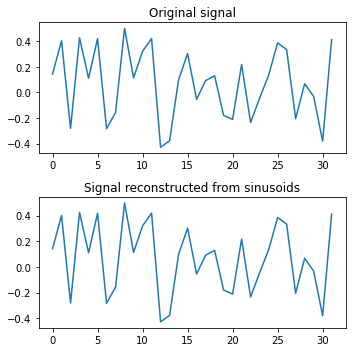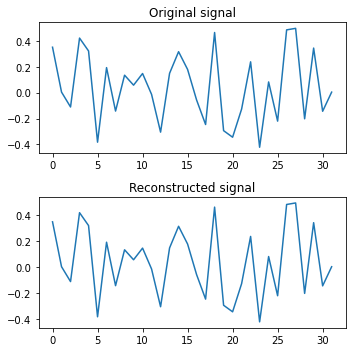The Fourier transform is a neural network
We can consider the discrete Fourier transform (DFT) to be an artificial neural network: it is a single layer network, with no bias, no activation function, and particular values for the weights. The number of output nodes is equal to the number of frequencies we evaluate.
Here is the DFT:
\[y_k = \displaystyle \sum_{n=0}^{N-1} x_n \cdot \exp(-i\frac{2 \pi k}{N}n) \tag{1}\]Where $k$ is the number of cycles per $N$ samples, $x_n$ is the signal’s value at sample $n$, and $N$ is the length of the signal.
(A signal can be written as the sum of sinusoids. $y_k$ is a complex value that gives us information about the sinusoid of frequency $k$ in signal $\boldsymbol{x}$; from $y_k$ we can compute the amplitude and phase (i.e. location) of the sinusoid.)
We can rewrite (1) using matrix multiplication:
\[y_k = [x_0, x_1,... x_{N-1}] \begin{bmatrix} \exp(0)\\ \exp(-i\frac{2 \pi k}{N})\\ \exp(-i\frac{2 \pi k}{N}2)\\ \exp(-i\frac{2 \pi k}{N}3)\\ \exp(-i\frac{2 \pi k}{N}4)\\ \vdots \\ \exp(-i\frac{2 \pi k}{N}(N-1)) \end{bmatrix}\]This gives us the Fourier value for a particular $k$. However, we most commonly want to compute the full frequency spectrum, i.e. values of $k$ from $[0, 1, … N-1]$. We can use a matrix for this ($k$ is incremented column-wise, and $n$ row-wise):
More concisely:
\[\boldsymbol{y} = \boldsymbol{x} W_{Complex Fourier} \tag{2}\]This should look familiar, because it is a neural network layer with no activation function and no bias. The matrix of exponentials contains our weights, which we’ll call “complex Fourier weights”. Usually we don’t know the weights of our neural networks in advance, but in this case we do.
Non-complex
However, we typically don’t use complex numbers for neural networks. To fit in with this, we’ll double the size of our matrix. The left half will contain the real values, and the right half the imaginary values.
Recall that:
\[e^{-i\theta} = cos(\theta) - i sin(\theta)\]Substituting in $ \theta = \frac{2 \pi k}{N}n $ from our DFT expression [1], we get:
\[\exp(-i \frac{2 \pi k}{N}n) = cos(\frac{2 \pi k}{N}n) - i sin(\frac{2 \pi k}{N}n)\]Then we use the real part (the $cos$ term) for the left half of our matrix, and the imaginary part (the $sin$ term) for the right half.
…More concisely:
\[\hat{\boldsymbol{y}} = \boldsymbol{x} W_{Fourier} \tag{3}\]We’ll call $W_{Fourier}$, “Fourier weights”. Note that $\hat{\boldsymbol{y}}$ and $\boldsymbol{y}$ effectively contain the same information, but $\hat{\boldsymbol{y}}$ doesn’t use complex numbers, so it is twice as long. In other words, we could compute amplitudes and phases using either $W_{Fourier}$ or $W_{Complex Fourier}$, but we probably want to use $W_{Fourier}$ in order to avoid complex numbers.
We are now equipped to add Fourier layers to our networks, if we so choose…
Computing the Fourier transform using Fourier weights
Let’s implement the method shown above (non-complex, expression 3), and check it is correct using the fast Fourier transform.
import numpy as np
def create_fourier_weights(signal_length):
"Create weights, as described above."
k_vals, n_vals = np.mgrid[0:signal_length, 0:signal_length]
theta_vals = 2 * np.pi * k_vals * n_vals / signal_length
return np.hstack([np.cos(theta_vals), -np.sin(theta_vals)])
# Generate data:
signal_length = 64
x = np.random.random(size=[1, signal_length]) - 0.5
# Compute Fourier transform using method described above:
W_fourier = create_fourier_weights(signal_length)
y = np.matmul(x, W_fourier)
# Compute Fourier transform using the fast Fourier transform:
fft = np.fft.fft(x)
y_fft = np.hstack([fft.real, fft.imag])
# Compare the results:
print('rmse: ', np.sqrt(np.mean((y - y_fft)**2)))
rmse: 1.5429611622665193e-14
The tiny error confirms that we are computing what we expect.
Another way of checking is to reconstruct the signal:
import matplotlib.pyplot as plt
y_real = y[:, :signal_length]
y_imag = y[:, signal_length:]
tvals = np.arange(signal_length).reshape([-1, 1])
freqs = np.arange(signal_length).reshape([1, -1])
arg_vals = 2 * np.pi * tvals * freqs / signal_length
sinusoids = (y_real * np.cos(arg_vals) - y_imag * np.sin(arg_vals)) / signal_length
reconstructed_signal = np.sum(sinusoids, axis=1)
print('rmse:', np.sqrt(np.mean((x - reconstructed_signal)**2)))
plt.subplot(2, 1, 1)
plt.plot(x[0,:])
plt.title('Original signal')
plt.subplot(2, 1, 2)
plt.plot(reconstructed_signal)
plt.title('Signal reconstructed from sinusoids after DFT')
plt.tight_layout()
plt.show()
rmse: 2.3243522568191728e-15

Learning the Fourier transform via gradient-descent
We don’t need to pre-compute the weights, like we did above, we can instead learn them.
(Note, this may be the most interesting example, since the system being optimized is nonlinear.)
First, similarly to endolith (see GitHub Gist), we will use the FFT to train a network to carry out the DFT:
import tensorflow as tf
signal_length = 32
# Initialise weight vector to train:
W_learned = tf.Variable(np.random.random([signal_length, 2 * signal_length]) - 0.5)
# Expected weights, for comparison:
W_expected = create_fourier_weights(signal_length)
losses = []
rmses = []
for i in range(1000):
# Generate a random signal each iteration:
x = np.random.random([1, signal_length]) - 0.5
# Compute the expected result using the FFT:
fft = np.fft.fft(x)
y_true = np.hstack([fft.real, fft.imag])
with tf.GradientTape() as tape:
y_pred = tf.matmul(x, W_learned)
loss = tf.reduce_sum(tf.square(y_pred - y_true))
# Train weights, via gradient descent:
W_gradient = tape.gradient(loss, W_learned)
W_learned = tf.Variable(W_learned - 0.1 * W_gradient)
losses.append(loss)
rmses.append(np.sqrt(np.mean((W_learned - W_expected)**2)))
Final loss value 1.6738563548424711e-09
Final weights' rmse value 3.1525832404710523e-06


This confirms that neural networks are capable of learning the discrete Fourier transform.
However, this example is contrived -
if we are going to train a single layer to learn the Fourier transform, we might as well use create_fourier_weights directly (or tf.signal.fft, etc.).
Learning the Fourier transform via reconstruction
We used the FFT above, to teach the network to perform the Fourier transform. Let’s not use it anymore, and instead learn the DFT by training the network to reconstruct the input signal.
W_learned = tf.Variable(np.random.random([signal_length, 2 * signal_length]) - 0.5)
tvals = np.arange(signal_length).reshape([-1, 1])
freqs = np.arange(signal_length).reshape([1, -1])
arg_vals = 2 * np.pi * tvals * freqs / signal_length
cos_vals = tf.cos(arg_vals) / signal_length
sin_vals = tf.sin(arg_vals) / signal_length
losses = []
rmses = []
for i in range(10000):
x = np.random.random([1, signal_length]) - 0.5
with tf.GradientTape() as tape:
y_pred = tf.matmul(x, W_learned)
y_real = y_pred[:, 0:signal_length]
y_imag = y_pred[:, signal_length:]
sinusoids = y_real * cos_vals - y_imag * sin_vals
reconstructed_signal = tf.reduce_sum(sinusoids, axis=1)
loss = tf.reduce_sum(tf.square(x - reconstructed_signal))
W_gradient = tape.gradient(loss, W_learned)
W_learned = tf.Variable(W_learned - 0.5 * W_gradient)
losses.append(loss)
rmses.append(np.sqrt(np.mean((W_learned - W_expected)**2)))
Final loss value 4.161919455121241e-22
Final weights' rmse value 0.20243339269590094



And we pretty much learn the Fourier transform. The learned weights don’t get as close to the Fourier weights as they did in the example above, but the reconstructed signals are perfect.
Amplitude and phase reconstruction (nonlinearities)
Let’s now calculate the amplitude and phase of the sinusoids, and use these to reconstruct the signal. This time the gradient of the weights with w.r.t. the loss has to go through nonlinearities (which, fortunately, are differentiable), because we haven’t simplified the system into its linear form.
W_learned = tf.Variable(np.random.random([signal_length, 2 * signal_length]) - 0.5)
losses = []
rmses = []
for i in range(10000):
x = np.random.random([1, signal_length]) - .5
with tf.GradientTape() as tape:
y_pred = tf.matmul(x, W_learned)
y_real = y_pred[:, 0:signal_length]
y_imag = y_pred[:, signal_length:]
amplitudes = tf.sqrt(y_real**2 + y_imag**2) / signal_length
phases = tf.atan2(y_imag, y_real)
sinusoids = amplitudes * tf.cos(arg_vals + phases)
reconstructed_signal = tf.reduce_sum(sinusoids, axis=1)
loss = tf.reduce_sum(tf.square(x - reconstructed_signal))
W_gradient = tape.gradient(loss, W_learned)
W_learned = tf.Variable(W_learned - 0.5 * W_gradient)
losses.append(loss)
rmses.append(np.sqrt(np.mean((W_learned - W_expected)**2)))
Final loss value 2.2379359316633115e-21
Final weights' rmse value 0.2080118219691059



Once again we get perfect reconstructions, so we know that the amplitudes and phases must be accurate. However, as before, the learned weights aren’t exactly the same as the Fourier weights (but pretty close). So we can surmise that there is some flexibility in the weights that result in the Fourier transform, and that gradient descent takes us to a local optimum.
We are left with the questions:
- What is the explanation for the flexibility in the weights? How much flexibility is there?
- Do we ever benefit from explicitly putting Fourier layers into our models? Or are we better off using good architectures and assuming the model will learn what it needs to?
Note that the first sentence of this post can be made more general:
We can write any linear mapping (including the DFT) as an artificial neural network with no bias, no activation function, and particular values for the weights. This is because both linear mappings and linear neural network layers can be written as matrix multiplication.
We can take this further, and argue that all kinds of things are neural networks (which is a fun exercise). But in actuality, having nonlinearities, i.e. activation functions, and multiple layers, is essential most of the time.
References
https://en.wikipedia.org/wiki/Discrete_Fourier_transform
Training neural network to implement discrete Fourier transform (DFT/FFT) - 2018 - https://gist.github.com/endolith/98863221204541bf017b6cae71cb0a89
Discrete Fourier Transform Computation Using Neural Networks - 2008 - https://publik.tuwien.ac.at/files/PubDat_171587.pdf